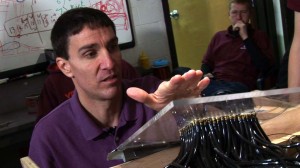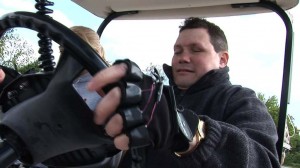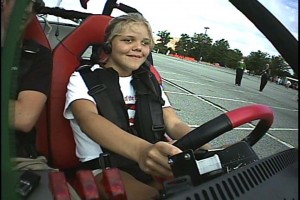While there have been plenty of advances when it comes to enabling the blind to participate in daily life, they’re still at a severe disadvantage in a society so heavily dependent on personal transportation.
But even that obstacle soon could be overcome, suggests the National Federation of the Blind, which is developing a high-tech version of the Ford Escape designed to allow the blind to drive.
Developed in cooperation with Virginia Tech, the vehicle will make its running debut on January 29, 2011 during the “Blind Driver Challenge,” an on-track event that will lead into the annual Rolex 24 endurance race at Florida’s Daytona International Speedway.
“I’m not prepared to say when a vehicle like this will be in a dealership where you could walk in and buy one, but with a little imagination, I’m convinced that day will come,” says Federation board member Tarnell Diggs.
Himself blind, Diggs tells TheDetroitBureau.com that, “The primary purpose” in developing the prototype, “is to show that blind people have the capacity to dream of a better world than we have today – which includes society recognizing that blind people have the capacity to act on their own behalf.”
The modified Ford uses a technology called “non-visual interfaces” to allow a blind driver to “see” what’s happening on the road around the vehicle and maneuver – steer, brake and accelerate – just like a sighted motorist. Many of the specific systems in use on the Escape prototype were previously used on a Virginia Tech entry into the 2007 DARPA Grand Challenge. Part of an ongoing series of “races” by the defense research group, the Challenge was aimed at developing fully autonomous vehicles that could drive on their own, without human intervention, on an extended course.

Virginia Tech's Mark Roane demonstrates the AirPix system, which can help blind motorists "see" what's happening around them.
Today’s most advanced vehicles include a variety of semi-autonomous technologies, such as Lane Departure Warning, which can alert a motorist when a vehicle is in their blind spot, even gently nudge the car back into its lane. Volvo recently introduced a system designed for urban driving that can react fast if a pedestrian steps in front of a vehicle, even bringing it to a stop without the driver’s intervention. And some experts believe that within the next several decades it will be possibly to operate fully autonomous vehicles on public roadways.
But the vehicle the Federation of the Blind and Virginia Tech are developing is not intended to let the unsighted simply go along for the ride, but rather to enable them to become active drivers.
A system called AirPix will permit an unsighted driver to internally visualize what’s happening on the roadway, using a small tablet that functions much like an air hockey table. Puffs of air will illustrate where there are other cars or obstacles ahead.
DriveGrip, meanwhile, can alert the driver when and where to turn by using gloves that vibrate, like a muted cellphone.
Researchers at Virginia Tech contend that some of the systems they are developing could eventually make it safer for even sighted drivers to negotiate today’s crowded roads.
The Federation and Virginia Tech are announcing the project today at the Daytona speedway, and individual pieces of the car’s technology will be on display at the Federation’s annual convention, in Dallas, over the coming days.
The unsighted driver who will participate in the January 29 event has not yet been named, according to the National Federation of the Blind.
Board member Diggs hints that the modified Ford might not be the only vehicle participating in next January’s Blind Driver Challenge – which suggests that perhaps other autonomous or semi-autonomous automobiles will take to the track in January.



Why do we need a new car like this one? We already have a bunch driving blind now, some with and some without glasses on their faces.
LOL!